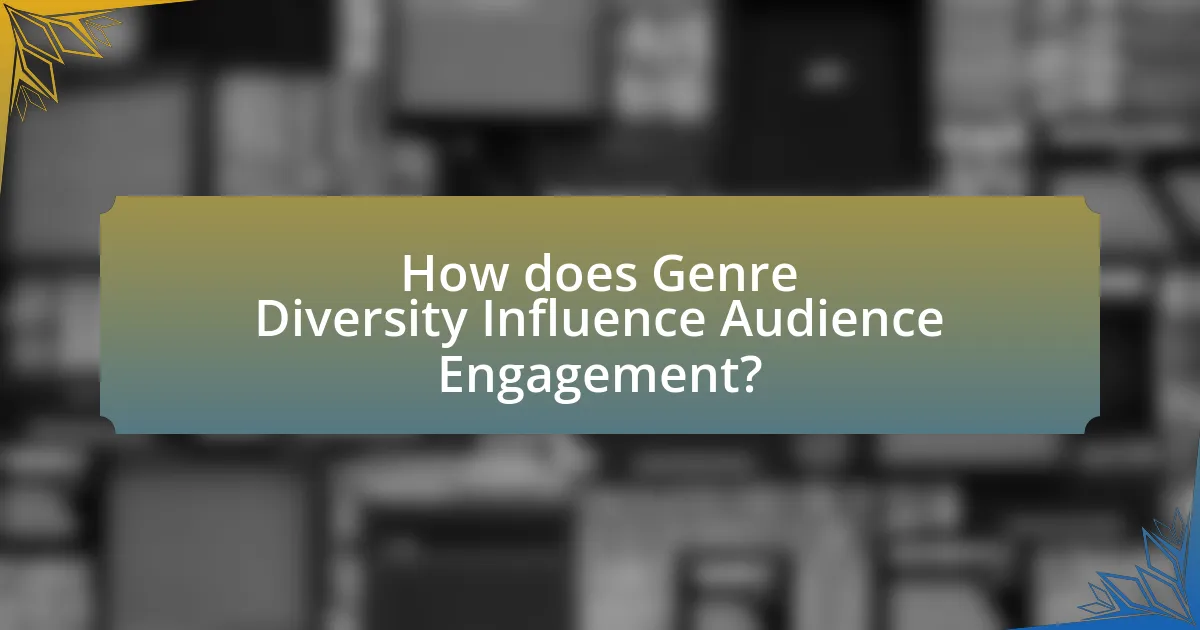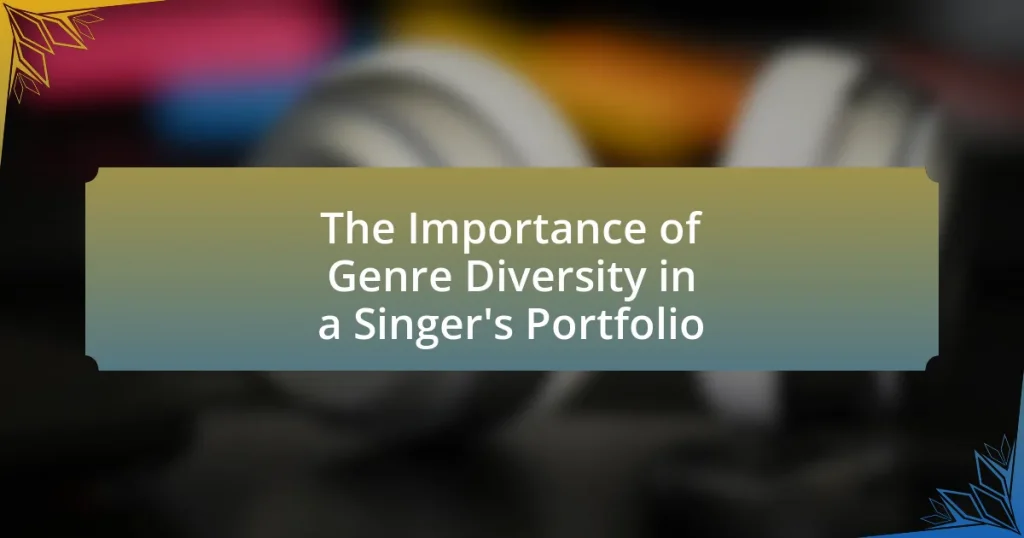The article focuses on the significance of genre diversity in a singer’s portfolio, highlighting its role in showcasing versatility and broadening audience appeal. It discusses how exploring multiple genres enhances a singer’s marketability, audience reach, and artistic expression, while also addressing the challenges faced during genre diversification. Key examples, such as Taylor Swift and Lady Gaga, illustrate the benefits of genre diversity, including increased creativity, audience engagement, and long-term career sustainability. The article also outlines practical steps for singers to diversify their portfolios and the resources available for learning new genres.
Why is Genre Diversity Important in a Singer’s Portfolio?
Genre diversity is important in a singer’s portfolio because it showcases versatility and broadens audience appeal. By incorporating multiple genres, a singer can attract different listener demographics, enhancing their marketability. For instance, artists like Taylor Swift have successfully transitioned between country, pop, and indie genres, which has significantly expanded their fan base and commercial success. This adaptability not only demonstrates artistic range but also allows singers to explore various creative expressions, ultimately leading to a more robust and sustainable career in the music industry.
How does genre diversity impact a singer’s career?
Genre diversity significantly enhances a singer’s career by broadening their audience reach and increasing marketability. When a singer explores multiple genres, they attract fans from various musical backgrounds, which can lead to higher sales and streaming numbers. For instance, artists like Taylor Swift have successfully transitioned between country, pop, and indie genres, resulting in multiple Grammy Awards and a diverse fan base. This versatility not only opens up more performance opportunities but also allows for collaborations across genres, further expanding their influence and relevance in the music industry.
What are the potential benefits of exploring multiple genres?
Exploring multiple genres offers significant benefits, including enhanced creativity, broader audience reach, and improved adaptability. By engaging with various musical styles, artists can stimulate their creativity, leading to innovative sounds and unique compositions. Research indicates that artists who diversify their genre exposure often attract a wider fan base, as they appeal to different listener preferences. Additionally, versatility in genre allows singers to adapt to changing market trends and audience demands, ensuring longevity in their careers. For instance, artists like Taylor Swift have successfully transitioned across genres, which has contributed to her sustained popularity and commercial success.
How can genre diversity enhance a singer’s artistic expression?
Genre diversity enhances a singer’s artistic expression by allowing them to explore a wider range of emotions and styles, thereby enriching their creative output. When singers incorporate various genres, such as pop, jazz, rock, and classical, they can experiment with different vocal techniques and lyrical themes, which broadens their artistic palette. For instance, artists like Lady Gaga and Halsey have successfully navigated multiple genres, showcasing their versatility and attracting diverse audiences. This adaptability not only fosters innovation in their music but also helps them connect with listeners on different levels, ultimately leading to a more profound artistic identity.
What challenges do singers face when diversifying their genres?
Singers face several challenges when diversifying their genres, primarily including the risk of alienating their existing fan base and the difficulty of mastering new vocal techniques. When a singer shifts to a different genre, they may lose listeners who prefer their original style, as evidenced by artists like Taylor Swift, who faced backlash from country fans when transitioning to pop. Additionally, each genre often requires distinct vocal skills and stylistic nuances; for instance, a singer trained in classical music may struggle with the improvisational aspects of jazz. This need for adaptation can lead to a steep learning curve, impacting the singer’s confidence and performance quality.
How can a singer overcome genre-specific stereotypes?
A singer can overcome genre-specific stereotypes by actively diversifying their musical repertoire and collaborating with artists from different genres. This approach not only broadens their artistic range but also challenges preconceived notions about their capabilities. For instance, artists like Taylor Swift successfully transitioned from country to pop, demonstrating that versatility can reshape public perception. Additionally, research indicates that exposure to diverse musical styles can enhance creativity and innovation, further supporting a singer’s ability to break free from genre constraints.
What skills are necessary for mastering multiple genres?
Mastering multiple genres requires adaptability, vocal versatility, and a deep understanding of musical theory. Adaptability allows singers to adjust their style and technique to fit various genres, while vocal versatility enables them to modify their vocal quality and range to suit different musical demands. A solid grasp of musical theory aids in recognizing genre-specific elements such as rhythm, melody, and harmony, which are crucial for effective performance across diverse styles. These skills collectively enhance a singer’s ability to engage with a wide array of musical expressions, making them more versatile and appealing in the industry.

How does Genre Diversity Influence Audience Engagement?
Genre diversity significantly enhances audience engagement by appealing to a broader range of listener preferences. When artists incorporate multiple genres into their portfolios, they attract diverse demographics, increasing their overall audience base. For instance, a study by the University of Southern California found that musicians who blend genres can increase their streaming numbers by up to 30%, as varied styles resonate with different listener groups. This diversity not only retains existing fans but also draws in new ones, fostering a more engaged and loyal audience.
Why do audiences appreciate genre diversity in music?
Audiences appreciate genre diversity in music because it enhances their listening experience and allows for a broader emotional connection. This diversity exposes listeners to various styles, rhythms, and cultural influences, which can evoke different feelings and memories. Research indicates that exposure to diverse musical genres can increase overall enjoyment and satisfaction, as it caters to varied tastes and preferences. For instance, a study published in the Journal of Consumer Research found that listeners who engage with multiple genres report higher levels of happiness and fulfillment in their music consumption. This appreciation for genre diversity ultimately enriches the cultural landscape and fosters a more inclusive musical community.
What role does genre diversity play in attracting a wider fan base?
Genre diversity plays a crucial role in attracting a wider fan base by appealing to varied musical tastes and preferences. When artists incorporate multiple genres into their portfolios, they can reach different demographic groups, thereby expanding their audience. For instance, a study by the University of Southern California found that artists who blend genres, such as pop and hip-hop, often see increased streaming numbers and broader media coverage, which directly correlates with a larger fan base. This diversification allows artists to engage listeners who may not typically enjoy a single genre, thus enhancing their overall marketability and popularity.
How can genre diversity affect audience loyalty?
Genre diversity can enhance audience loyalty by attracting a broader demographic and keeping existing fans engaged through varied musical experiences. When artists explore multiple genres, they can appeal to different tastes and preferences, which can lead to increased fan base growth. For instance, a study by the University of Southern California found that artists who incorporate diverse musical styles tend to have a more extensive reach and higher streaming numbers, indicating a stronger connection with listeners. This variety not only satisfies the curiosity of fans but also fosters a sense of loyalty as audiences feel they are part of an evolving artistic journey.
What strategies can singers use to effectively showcase genre diversity?
Singers can effectively showcase genre diversity by incorporating a variety of musical styles into their repertoire, collaborating with artists from different genres, and utilizing social media platforms to share diverse content. By performing songs across genres such as pop, rock, jazz, and classical, singers demonstrate their versatility and appeal to a broader audience. Collaborations with artists from various musical backgrounds not only enhance their exposure but also enrich their artistic expression. Additionally, leveraging social media allows singers to reach diverse audiences and showcase their genre versatility through videos, live performances, and genre-specific content, which can lead to increased fan engagement and opportunities.
How can collaboration with other artists enhance genre exploration?
Collaboration with other artists enhances genre exploration by allowing musicians to blend diverse influences and techniques, leading to innovative sounds. When artists from different genres work together, they share unique perspectives and skills, which can result in the creation of hybrid genres. For instance, the collaboration between country artist Lil Nas X and producer Billy Ray Cyrus on “Old Town Road” successfully merged country and hip-hop, achieving unprecedented chart success. This demonstrates how cross-genre partnerships can push creative boundaries and expand an artist’s portfolio, ultimately enriching their musical identity.
What marketing techniques can promote a diverse musical portfolio?
Utilizing social media marketing effectively can promote a diverse musical portfolio. By leveraging platforms like Instagram, TikTok, and YouTube, artists can showcase various genres through engaging content, such as short clips, live performances, and behind-the-scenes footage. Research indicates that 54% of social media users prefer to discover new music through these platforms, highlighting their effectiveness in reaching diverse audiences. Additionally, collaborations with artists from different genres can expand an artist’s reach and introduce their music to new fan bases, further enhancing genre diversity.

What are the Long-Term Benefits of Genre Diversity for Singers?
The long-term benefits of genre diversity for singers include enhanced vocal versatility, increased marketability, and broader audience reach. By exploring various musical styles, singers develop a wider vocal range and adaptability, which can lead to improved performance skills and artistic expression. Research indicates that artists who diversify their genres often experience greater commercial success; for instance, a study by the University of Southern California found that musicians who engage in multiple genres tend to have longer careers and higher album sales. Additionally, genre diversity allows singers to connect with different demographics, expanding their fan base and opportunities for collaboration.
How does genre diversity contribute to a singer’s longevity in the industry?
Genre diversity significantly contributes to a singer’s longevity in the industry by allowing them to reach a broader audience and adapt to changing musical trends. When artists explore multiple genres, they can attract fans from different demographics, which enhances their marketability and relevance. For instance, artists like Taylor Swift successfully transitioned from country to pop, expanding her fan base and maintaining chart success over the years. This adaptability not only keeps their music fresh but also helps them stay competitive in an evolving industry landscape, as evidenced by the fact that artists who diversify their sound often experience longer careers and sustained popularity.
What examples exist of successful artists who embraced genre diversity?
Successful artists who embraced genre diversity include Prince, who seamlessly blended rock, funk, pop, and R&B throughout his career, resulting in numerous chart-topping hits and critical acclaim. Another example is Taylor Swift, who transitioned from country to pop and indie folk, showcasing her versatility and expanding her audience significantly. Additionally, Billie Eilish has incorporated elements of pop, electronic, and alternative music, which has led to multiple Grammy Awards and a strong global following. These artists demonstrate that embracing genre diversity can enhance artistic expression and commercial success.
How can genre diversity lead to new creative opportunities?
Genre diversity can lead to new creative opportunities by allowing artists to explore different musical styles, which can enhance their artistic expression and broaden their audience reach. When singers incorporate various genres, they can experiment with unique sounds and techniques, fostering innovation in their work. For instance, artists like Taylor Swift successfully transitioned from country to pop, resulting in a significant expansion of her fan base and commercial success. This adaptability not only attracts diverse listeners but also encourages collaborations with artists from different genres, further enriching their creative output.
What practical steps can singers take to diversify their portfolios?
Singers can diversify their portfolios by exploring multiple musical genres, collaborating with different artists, and engaging in various performance opportunities. By experimenting with genres such as pop, jazz, classical, and world music, singers can reach broader audiences and showcase their versatility. Collaborating with artists from different backgrounds not only enhances creativity but also introduces singers to new fan bases. Additionally, participating in live performances, studio recordings, and digital platforms like streaming services allows singers to expand their reach and adapt to changing market demands. This approach is supported by industry trends indicating that artists who embrace genre diversity often experience increased visibility and commercial success.
How can singers identify genres they want to explore?
Singers can identify genres they want to explore by actively listening to a wide variety of music styles and assessing their personal preferences and vocal strengths. Engaging with different genres allows singers to discover what resonates with them emotionally and technically. For instance, a singer might find that they excel in the nuances of jazz while enjoying the storytelling aspect of country music. Research indicates that exposure to diverse musical styles can enhance a singer’s adaptability and creativity, which is crucial for genre exploration. By analyzing their reactions to various genres and experimenting with different vocal techniques, singers can make informed decisions about which genres to pursue further.
What resources are available for singers to learn new genres?
Singers can utilize various resources to learn new genres, including online courses, vocal coaches, and genre-specific workshops. Online platforms like MasterClass and Coursera offer courses taught by industry professionals, covering diverse genres such as jazz, pop, and classical. Additionally, working with vocal coaches who specialize in different styles can provide personalized guidance and techniques tailored to specific genres. Workshops and masterclasses hosted by music schools or local music organizations also present opportunities for hands-on learning and exposure to new styles. These resources collectively enhance a singer’s versatility and adaptability across multiple musical genres.















